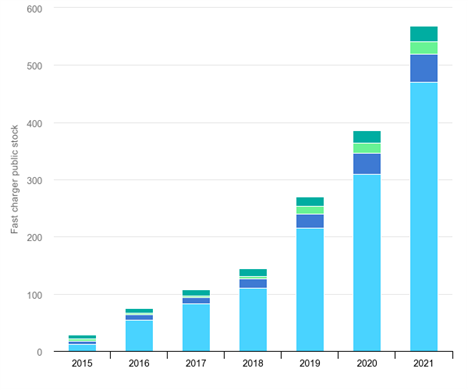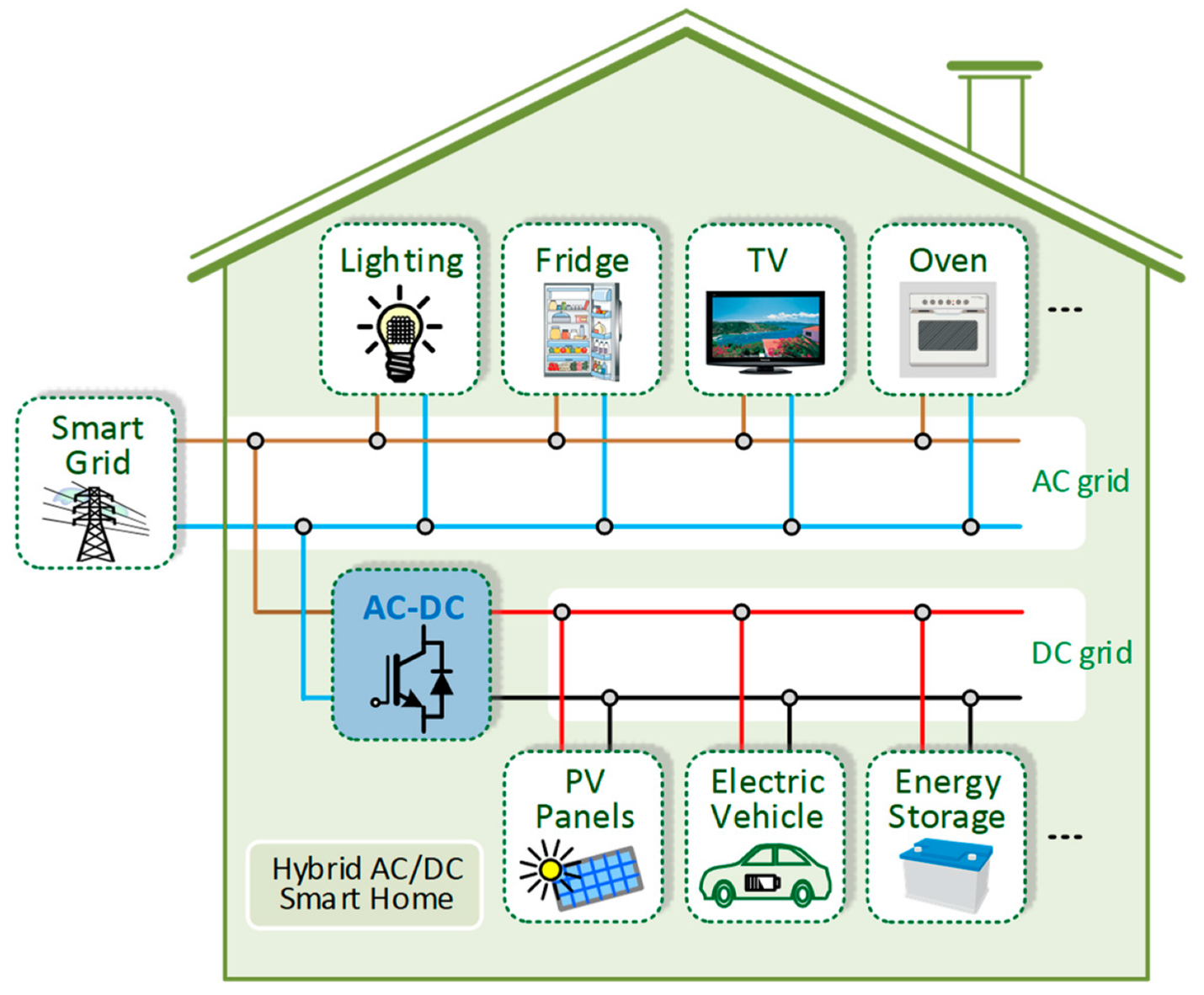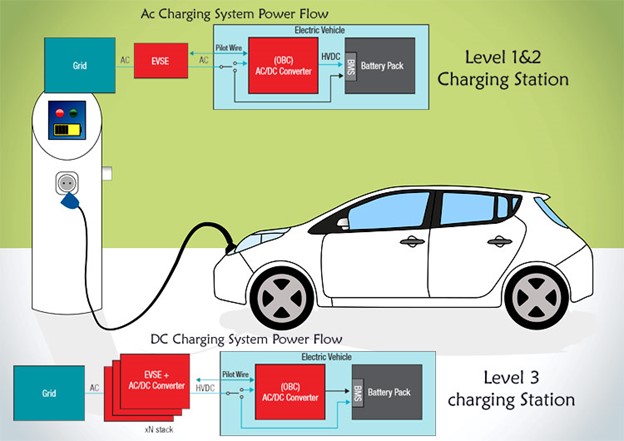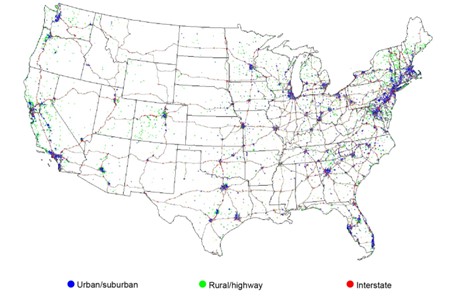[Editor’s note: “The Hidden Play in the Largest Transportation Shift Since the Model T” was previously published in May 2022. It has since been updated to include the most relevant information available.]
If you’re looking to play the multi-trillion-dollar Electric Vehicle Revolution, I have a suggestion for you. Consider EV charging stocks. After all, what good is a car without a gas station?
Not much good at all. It’s useless as a means of transportation unless it has fuel, which gas stations provide. No gas stations mean no usable cars.
By that same token, then, what good is an electric vehicle without an EV charging station?
None at all. EVs run on electric charge. Once that charge runs out, your EV becomes nothing more than a large paper weight.
No charging stations mean no usable EVs.
Therefore, the electric vehicle megatrend where everyone goes all in on Tesla (Nasdaq:TSLA), Lucid (Nasdaq:LCID), etc., isn’t possible. That is, unless EV charging infrastructure matches our supply of EVs.
In the recently released 2022 EV Market Outlook report, the International Energy Agency said the number of EV chargers would have to increase 12X globally by 2030 for companies and governments to reach the low-end of their targets for 30% of new car sales to be electric by then.

In other words, the EV market will grow by around 3X to 4X over the next decade. But the EV charging market will grow by 12X over that same stretch.
That means if you want to play the EV Revolution for truly enormous gains, forget about EV stocks. Buy EV charging stocks instead.
And we just happen to have the top pick in the EV charging space.
Gaining an Edge in EV Charging
Considering what you just read, you’re probably thinking that it’s time to rush out and load up on some EV charging stocks, right?
Not so fast.
There are lots of EV charging companies out there today. Not all will make it. Indeed, only a handful will make it big. Most will fail. So, it’s important to make the distinction to buy the best EV charging stocks.
To know which are “the best,” we need to first understand EV charging technology.
That analysis starts with one fundamental question: How does electricity work?
In short, we generate energy at a power source, like a coal-fired power plant or a solar farm. Then, we promote the flow of electrons (charged particles that carry electric power) from that power source to the rest of the world via wires. This flow of electrons is called a “current.”
That current can take two forms: alternating current (AC) or direct current (DC). DC is a direct constant flow of electrons through the wire. It results in heavy power delivery but also in significant drain on the grid. AC is an oscillating flow of electrons that results in lower power delivery but a much more manageable load on the grid.
Since the grid has always been load-constrained, society decided long ago to build it on AC. But today’s batteries can only store power as DC. Indeed, AC is physically impossible to store.
That’s why most consumer electronics devices – like laptops – come with power cords with big “boxes” in the middle of them. Those boxes are AC/DC converters, which convert the AC power from the grid to DC power that can be stored in your laptop.

EV charging works in much the same way.
EV chargers plug into the grid, which provides AC power. That AC power is then pumped into the EV. On board every EV, there is an AC/DC converter that transforms the AC power from the charger into usable DC power, which is then stored in the car’s battery.
Simple enough, right?
How to Pick the Best EV Charging Stocks
Understanding how EV charging works isn’t all you need to know to pick the best EV charging stocks. You also need to know the different types of EV chargers out there so that you can pick the companies that make the most useful and highest-quality products.
There are two classifications of AC electric vehicle chargers – L1 and L2.
L1 chargers are the most basic . They’re slow but really cheap. They’ll give you about three to five miles of EV range per hour of charging. Given that they’re low-cost, low-performance in nature, L1 chargers are common as residential solutions. Bu they’re very rarely used beyond the home.
L2 chargers are a big step-up from L1s . They’re much faster but also much more expensive. They’ll give you around 30 miles of EV range per hour of charging. These L2s constitute the majority of chargers on the road today.
Now, there are also DC fast chargers. These are fundamentally distinct from AC chargers. They have built-in AC/DC converters, which convert AC power from the grid into DC power within the actual charger itself. What this enables, then, is for the charger to pump DC power directly into an EV battery, completely bypassing the AC/DC converter in the car and, therefore, resulting in a far more powerful charge.
These chargers are really fast — and really expensive. As a result, they can give you over 100 miles of EV range per hour of charging. But there aren’t many of them on the roads these days — a few thousand across the whole U.S.

Considering this context, it’s important to understand that the future of the EV charging landscape will be a mix of mostly L2 chargers throughout urban areas with some DC fast chargers on interstate highways.
That’s because L2 chargers are good enough. The reality is that the enormous shift from gas stations to charging ports will be accompanied by an equally enormous paradigm shift in where we “fill up” our vehicles.
Since EV chargers are tiny and can be built anywhere there’s an electric connection, the days of dedicated gas stations are over. You won’t see EV charging stations replace gas stations. You’ll see gas stations become extinct. And EV charging ports will pop up everywhere from your gym parking lot to your local grocery store and mall lots.
The result? You’ll constantly be charging your EV on the go. So long as you aren’t traveling hundreds of miles and/or between cities and states, L2 chargers will do the job just fine because you’ll be charging every time you’re grocery shopping or working out.
For those long road trips… well, that’s where DC fast chargers will be super useful.

Oh, and charging costs money… about $2 per 30 minutes of L2 charging in a public lot. To that end, the future of EV charging is super clear. Millions of L2 chargers will pop up across every parking lot in urban and suburban America, while DC fast-chargers will replace gas stations on interstate highways. And consumers will foot the bill for all of it.
That’s the future.
So… which EV stocks should you be buying right now to play that future?
The Final Word
The answer to this question is in my flagship research advisory service, Innovation Investor.
In that platform, we leverage a team of hypergrowth technology stock experts – including software engineers, data scientists, seasoned traders, and economists – to understand technological megatrends at their most fundamental level. We don’t just listen to management teams and read investor decks. We break down every company’s underlying technology at a fundamental level to assess its validity and capability – and its potential to change the world.
And we do this across every industry, for every technological breakthrough, and with every company. The end result? We identify early-stage hypergrowth tech stocks set for enormous long-term returns.
In the EV charging industry, we’ve found one stock significantly superior to all other EV charging stocks out there. This company has the best tech, the best strategy, and the most resources at its disposal to turn into the Shell or Exxon of EV charging.
To find out more about potential 5X to 10X EV charging stock – and a tiny battery stock that could advance the EV industry into a new era – you can learn more here.
P.S: Click here to watch our latest episode of Hypergrowth Investing.
On the date of publication, Luke Lango did not have (either directly or indirectly) any positions in the securities mentioned in this article.
